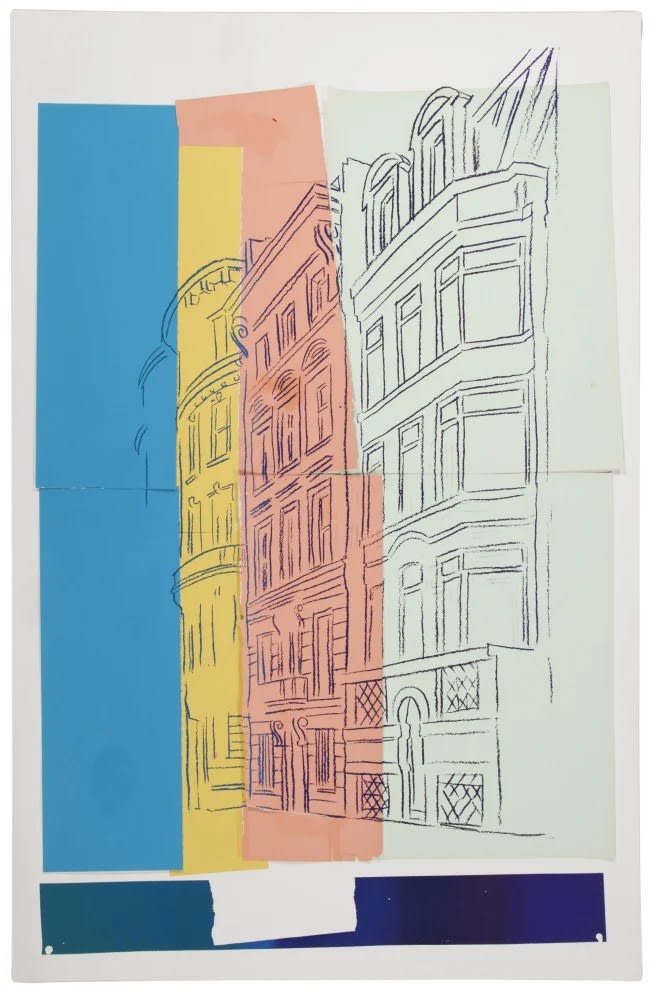
First used as an artists’ technique in the early twentieth century, the term collage - deriving from the French term papiers collés (or découpage) - is used to describe techniques of pasting paper cut-outs onto various surfaces. Techniques of collage were first used at the time of the invention of paper in China, around 200 BC. The use of collage can also be traced back to the 10th century in Japan, when calligraphers applied glued paper, using texts on surfaces, to write their poems. The layering of materials, which can include multiple media such as painting and drawing, photographs, newspaper and magazine cuttings, ribbons or text creates an assembly or a mesh of materials and mixed media. The collision of styles, colours and textures invites intriguing, layered combinations.
Andy Warhol’s “Viewpoint”: Experimenting with Colour and Form
Andy Warhol’s Viewpoint, is a lithograph from a small edition of 21 created in 1984. Thick blocks of colour are layered on top of the side view of a building in New York, creating a collage effect. Beginning to experiment with patterns of colour blocking, Viewpoint signified a turn in the artist’s style who sadly died three years after creating this print. His later works frequently featured blocks of colour applied over a drawn image which created a dialogue between the delicate drawing beneath the bold pops of colour. Better known for his prints that explored media, celebrity culture and consumerism, this print has a static, quieter subject matter.
Celebrating Subculture: Warhol’s Ladies and Gentlemen Series
‘Ladies and Gentlemen (F & S II.127)’ is a screenprint produced by Andy Warhol in 1975. Depicting a drag queen drawn from a Polaroid photograph he took at a nightclub, the layering of colours creates a collage-effect as different areas of the face are decorated: the red lips, blue eye, strips of purple and green on his neck. Warhol captures the artistry of the make-up of drag, as well as celebrating the colourful character and exuberance of the sitter’s spirit.
He initially stitched the outline of the subject with loose, fluid lines, before applying the mesh of colour blocks on top. In the mid-1970s, Warhol was very much involved in NYC nightlife. Clubs such as the Gilded Grape close to his studio proved to be a hub for transgender and gay community. His friend and art dealer Luciano Anselmino suggested that he should portray the vibrant characters he met, so Warhol photographed them with a Polaroid camera. The Ladies and Gentlemen series is a departure from the more famous faces he is a widely associated with - such as Marilyn Monroe and Jackie Onassis - in its celebration of a sidelined social group at the height of seventies subculture. Whilst he painted famed figures, he, importantly, also represented and empowered the playfulness party goes through his work.
Joan Miró’s Collage Technique in Sans titre (1933)
This collage, Sans titre, was created by Joan Miró in 1933. Featuring conté crayon and collage on paper, it depicts an abstract pencil drawing resembling a sea creature with five cut out pictures assembled in and around the shape that feature a range of unrelated images: fossils, sea creatures, a grazing cow and dancing lady. The elements were taken from postcards and illustrations in popular media, juxtaposed against lines that resemble figures floating. The vast amount of white space adds space and simplicity to the disjointed elements of the print.
Frequently experimenting with artistic processes and expressed, Miró played with a variety of materials and methods to craft an ever-evolving visual vocabulary. He 1933, he created a series of assemblages in response to the concept of ‘anti-painting’ whilst his fellow Surrealists explored their movement. In the late summer of 1933, he produced a series of collages “blending together his signature playfulness of line with cutouts of postcards, catalogues, magazines, and other found images” according to Sotheby’s.
His idea of anti-painting was “a revolt against a state of mind and traditional painting techniques that were later judged morally unjustifiable. It was also an attempt to express myself through new materials: bark, textile, fiber, assemblages of objects, collages, and so on” (quoted in Joan Miró, Painting and Anti-Painting, 1927-1937 (exhibition catalogue), The Museum of Modern Art, New York, p. 1).
In his study of these works, Jim Coddington observed that registration lines are visible on some of the compositions where Miró mapped the placement of postcards and collage elements. “The result of this highly deliberate and technically sophisticated process is a harmonized composition defined by a multitude of textures. In a poetic style unique to the artist, the collage unites dreamlike Surrealist manifestations of line and form with Dadaist impulses to assemble found materials, a combination that anticipated the assemblages of such postwar artists as Joseph Cornell and Robert Rauschenberg, the latter of whom frequently appropriated imagery from popular culture to create provocative collages” states Sotheby’s.
Keith Haring’s Apocalypse: Text and Image as Collage
David Hockney and the Multi-Perspective Collage Approach
David Hockney created collage-like creations with joiner photographers which were assembled from multiple photographers taken from different angles and perspectives. By doing this, Hockney challenges the traditional, singular viewpoint of a camera, compelling viewers to engage with the composition as a dynamic, multi-faceted narrative.
Grayson Perry’s Layered Prints: Narrative and Complexity
One of Grayson Perry's distinctive techniques in printmaking is the use of layering and collage. By combining various elements within a single print, he constructs multi-dimensional narratives that invite deeper exploration. Perry's layering technique creates a visual complexity that mirrors the intricate layers of human experience and societal constructs. Through this approach, he challenges the viewers to question and dissect the layers of meaning embedded within his prints.
For more information and to buy Andy Warhol prints, our available Keith Haring prints for sale and Grayson Perry art, contact sales@andipa.com or call +44 (0)20 7589 2371 for more information.
